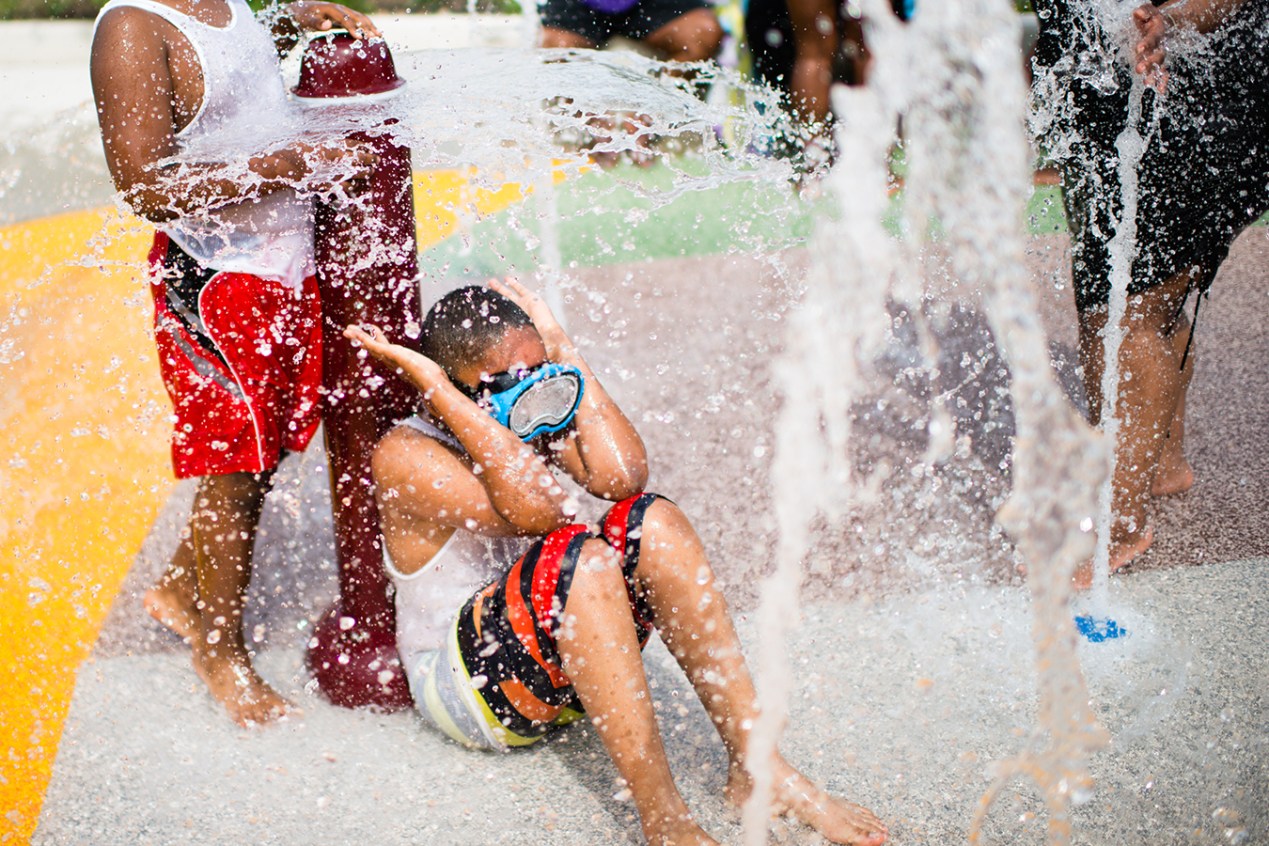Aaron McCullough brought his 3-year-old daughter, Ariana, to a playground in a leafy neighborhood of Rochester, New York, on a day in mid-June when the temperature topped out at 94 degrees.
The playground is one of seven spray parks in the city that offer cooling water whenever temperatures exceed 85 degrees.
Except during a pandemic.
“I was hoping that one of these water parks could open up and at least spray a little bit of water on us,” McCullough said.
Instead, he said, sweat dripping off his face, “there’s no water around at all.”
All of the city’s spray parks and air-conditioned cooling centers were shut down to slow the spread of COVID-19.
“Gathering in close proximity and engaging in physically strenuous behavior like running around the spray park appears to be a likely possibility for transmission,” said city spokesperson Justin Roj.
McCullough had bought Ariana a milkshake before they came to the park. It melted in his hand as she played on the slide.
“We’re not staying much longer,” he said. “Maybe 10 more minutes. If there were water, we’d be here till sundown.”
Across the country, authorities are finding that their usual strategies for protecting people against heat-related health problems are in direct conflict with their strategies for containing the coronavirus — and with record-breaking temperatures already recorded in some places before summer even officially began, those conflicts are likely to become more frequent.
“COVID-19 and climate change are on a collision course,” said New York City Emergency Management Department spokesperson Omar Bourne.
“There is no question that the challenges we face this summer are unprecedented.”
The balance between preventing COVID-19 and preventing heat-related illnesses is a tough one, experts said.
“I am very grateful that I am not responsible for making that very complicated decision,” said Dr. Andrea Miglani, the medical director of the emergency department at Strong Memorial Hospital in Rochester.
The first symptoms of overheating cause what doctors call heat exhaustion. They include heavy sweating, elevated pulse, tiredness, weakness and dizziness.
“But it’s when we cross into heatstroke that we get really worried,” Miglani said. At that point, she said, the body loses its ability to control temperature. The pulse races, sweating stops and fever can cause brain damage.
Miglani said one hot day might result in a slight bump in heat-related hospitalizations, but several hot days can bring cumulative effects, and the death toll can climb. People with underlying health conditions like heart disease and diabetes, and those older than 65, are especially at risk — just as with COVID-19.
Making matters worse, movie theaters, libraries and restaurants — places that are normally reliably air-conditioned respites on hot days — aren’t open in many parts of the country, said Miglani.
About 90% of households in the U.S. have air conditioning, according to federal census figures. But access is not evenly distributed. Poor and minority communities tend to suffer disproportionately during heat waves, but they have a much lower prevalence of air conditioning compared with richer, whiter neighborhoods.
The decision about whether and how to open cooling centers during the pandemic needs to happen on a local level, said Kristie Ebi, an epidemiologist on the steering committee of the Global Heat Health Information Network.
The federal Centers for Disease Control and Prevention offers guidelines for cities and states to deal with the competing problems. Suggestions include offering more assistance for people to pay their utility bills so that they can maintain air conditioning at home, having fever checks for people at cooling centers and a separate room for anyone with COVID-19 symptoms, and making masks and hand sanitizers available at the centers. Utility companies could also be required not to cut off anyone’s power during heat emergencies, the CDC suggests.
Across upstate New York, cities kept cooling centers closed earlier this month, even when temperatures surpassed 90 degrees.
In Los Angeles County, officials opened cooling centers when temperatures spiked, but they required masks and limited the number of people who could be inside at one time.
That might offer an example of how to cool off the people most vulnerable to heat-related health problems without drastically increasing the risk of COVID-19, Ebi said.
But, she acknowledged, what works in Los Angeles might not work in other places. “We’ve all got different infrastructure, different access to air conditioning, different public transport systems,” she said.
“The balance of risk is different everywhere,” Ebi said.
There is one piece of the puzzle that doctors said is the same everywhere: checking on friends, family and neighbors.
“This is another time when it’s important to emphasize the difference between social distancing and physical distancing,” said Miglani.
“Give them a call, leave them a note on their door, find out what you can do to help. A lot of times, very simple gestures can go a very long way,” she said.
This story is part of a partnership that includes Side Effects Public Media, NPR and Kaiser Health News.
